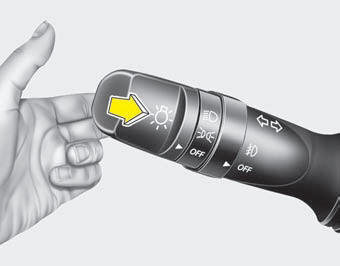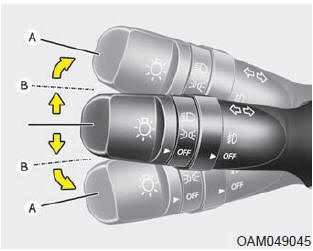 Kia Rio: Lighting control
Kia Rio: Lighting controlThe light switch has a Headlight and a Parking light position.
To operate the lights, turn the knob at the end of the control lever to one of the following positions:
(1) OFF position
(2) Parking light position
(3) Headlight position
(4) Auto light position (if equipped)

Parking light position (  )
)
When the light switch is in the parking light position (1st position), the tail, position, license and instrument panel lights will turn ON.

Headlight position (  )
)
When the light switch is in the headlight position (2nd position) the head, tail, position, license and instrument panel lights will turn ON.
The ignition switch must be in the ON position to turn on the headlights

Auto light position (if equipped)
When the light switch is in the AUTO light position, the taillights and headlights will turn ON or OFF automatically depending on the amount of light outside the vehicle.
Never place anything over sensor (1) located on the instrument panel. This will ensure better auto-light system control.
Don’t clean the sensor using a window cleaner. The cleaner may leave a light film which could interfere with sensor operation.
If your vehicle has window tint or other types of metallic coating on the front windshield, the Auto light system may not work properly.


High beam operation
To turn on the high beam headlights, push the lever away from you. Pull it back for low beams.
The high-beam indicator will light when the headlight high beams are switched on.
To prevent the battery from being discharged, do not leave the lights on for a prolonged time while the engine is not running.
WARNING - High beams
Do not use high beam when there are other vehicles. Using high beam could obstruct the other driver's vision.

To flash the headlights, pull the lever towards you. It will return to the normal (low-beam) position when released. The headlight switch does not need to be on to use this flashing feature.

Turn signals and lane change signals
The ignition switch must be on for the turn signals to function. To turn on the turn signals, move the lever up or down (A). The green arrow indicators on the instrument panel indicate which turn signal is operating. They will self-cancel after a turn is completed.
If the indicator continues to flash after a turn, manually return the lever to the OFF position.
To signal a lane change, move the turn signal lever slightly and hold it in position (B). The lever will return to the OFF position when released.
If an indicator stays on and does not flash or if it flashes abnormally, one of the turn signal bulbs may be burned out and will require replacement.
If an indicator flash is abnormally quick or slow, a bulb may be burned out or have a poor electrical connection in the circuit.
One-touch lane change function (if equipped)
To activate an one-touch lane change function, move the turn signal lever slightly and then release it. The lane change signals will blink 3 times.
✽ NOTICE
If an indicator flash is abnormally quick or slow, a bulb may be burned out or have a poor electrical connection in the circuit.

Front fog light (if equipped)
Fog lights are used to provide improved visibility when visibility is poor due to fog, rain or snow etc.The fog lights will turn on when the fog light switch (1) is turned to the on position after the headlights are turned on.
To turn off the fog lights, turn the switch (1) to the off position.
When in operation, the fog lights consume large amounts of vehicle electrical power. Only use the fog lights when visibility is poor.
 Hazard warning flasher lighting
Hazard warning flasher lighting Wipers & Washers
Wipers & WashersReceiver-Drier Replacement
1.
Remove the condenser.
2.
Remove the cap (B) on the bottom of the condenser with L wrench
(A).
Tightening torq ...
Front Fog Lamps Removal
1.
Disconnect the negative (-) battery terminal.
2.
Disconnect the fog lamp connector (A).
3.
Remove t ...
BJ Boot Replacement
1.
Remove the front driveshaft. (Refer to DS group - “Front Driveshaft”)
2.
Remove the TJ joint assembly. (Refer to DS group - “TJ Joint”)
...